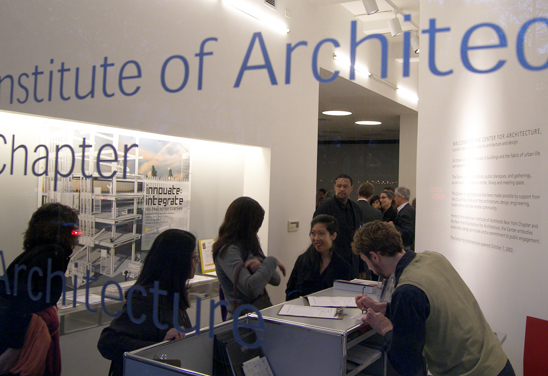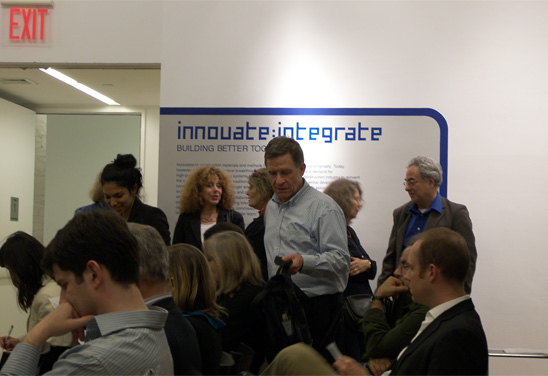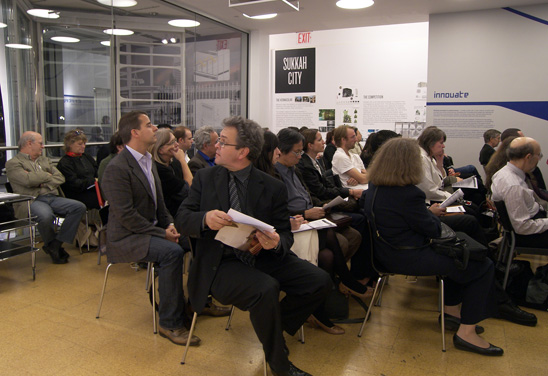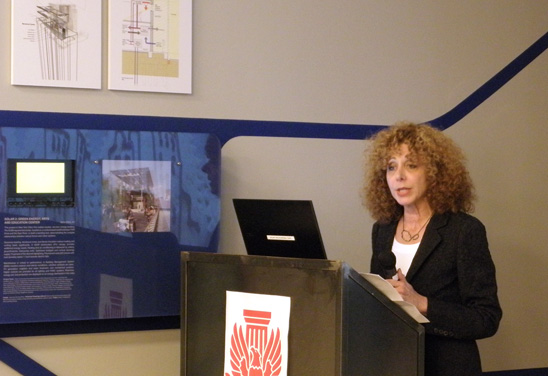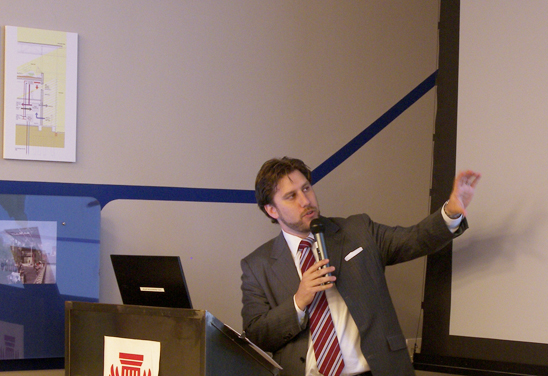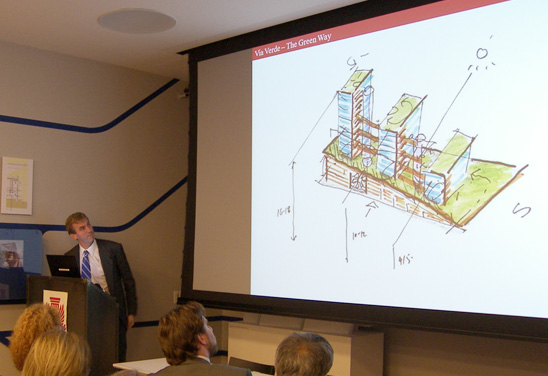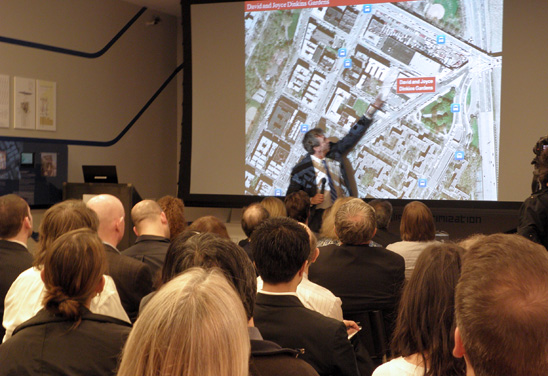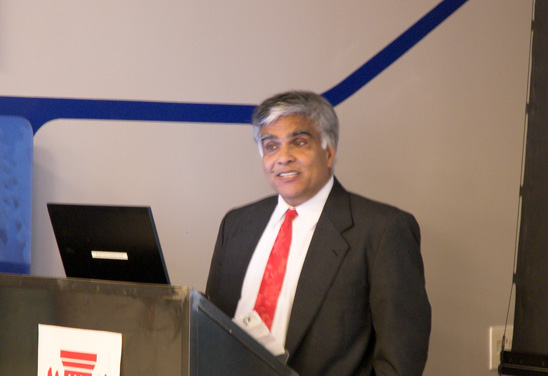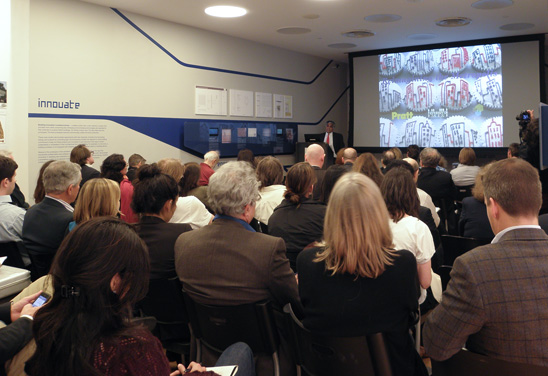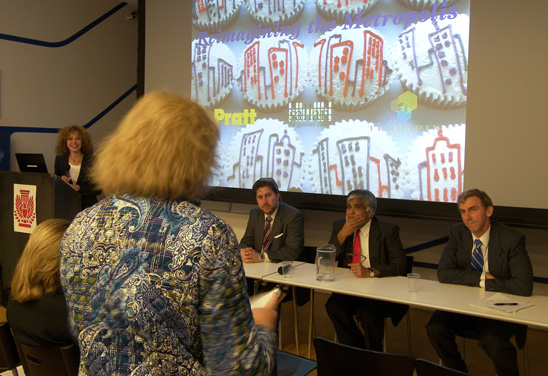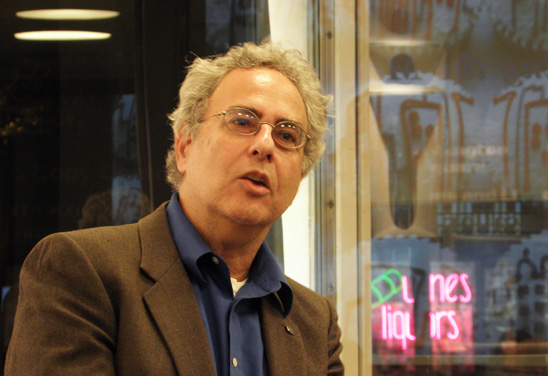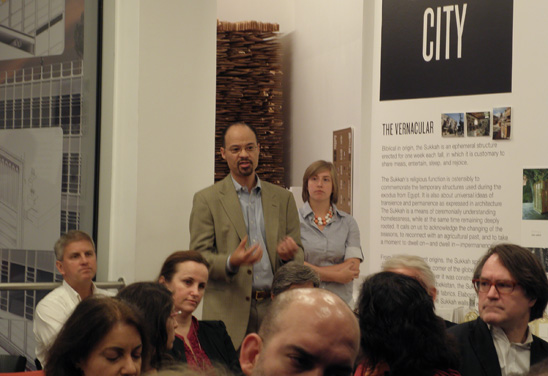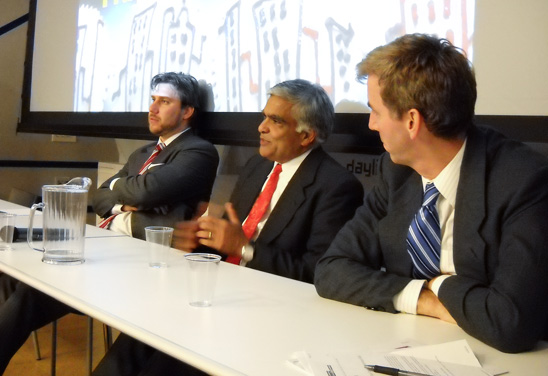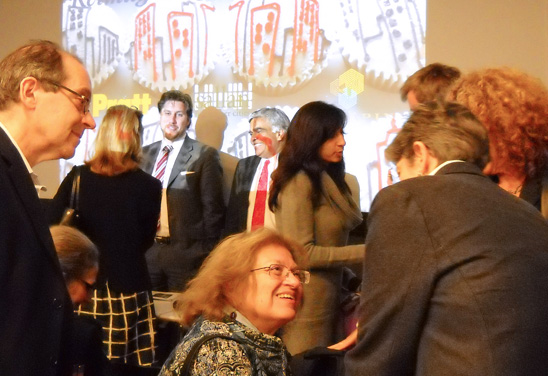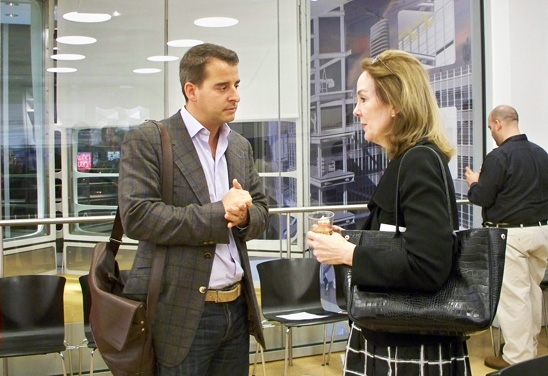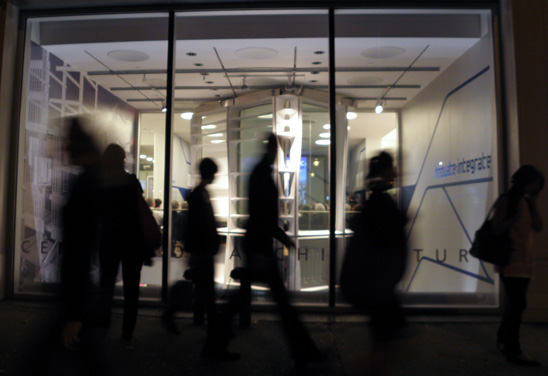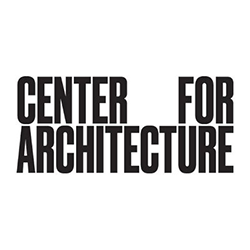Reimagining the Metropolis: Event One — The Big Picture
October 28, 2010
Reimagining the Metropolis: Event One Wrap-up
Reimagining the Metropolis, a four-part lecture series examining the trajectory of high performance building in New York City, was launched on Oct 28 at the Center for Architecture AIA-NY. The speakers at this first panel, "The Big Picture" were Adam Freed, Deputy Director, NYC Mayor's Office of Long-Term Planning and Sustainability; Paul Freitag, Director of Development, Jonathan Rose Companies; and, Ashok Gupta, Director of Energy Policy, Natural Resources Defense Council.
Nancy Anderson, Executive Director of the Sallan Foundation introduced the panel by citing local landmarks in the green building movement created over the last five years, including the application of LEED standards to municipal construction, development of energy efficient new and retrofits of existing buildings, in addition to wider introduction of cutting-edge government initiatives, like PlaNYC. After lauding the accomplishments of the movement, Anderson posed the question, "Perhaps this means we are done?", which lead to a few chuckles in the audience.
Adam Freed lead off with an announcement about the April 2011 update to the first PlaNYC 2030 now being written by the Mayor's Office of Long-Term Planning and Sustainability. Freed noted that it will take into account the increase in the City's population from 8.3 million in 2007 with a projected population of 9.3 million in 2030. Responding to the natural resource impacts and infrastructure pressures created this growing City, the Mayor's Office seeks to upgrade its water infrastructure by creating more permeable surfaces when replacing sidewalks and pavement, using the 1.6 billion square feet of rooftops to retain water during storms, and continuing work on the Third Water Tunnel — one of the largest municipal projects ever undertaken in New York. Focusing again on how to move toward more high performance building, Freed also emphasized the importance of benchmarking thousands of government and privately owned buildings to establish comparative base-line data on their energy and water consumption. This benchmarking requirement is in keeping with the Bloomberg administration mantra "What gets measured gets managed."
Paul Freitag spoke in depth about three projects the Jonathan Rose Companies (JRC) has pursued that incorporate new techniques and progress in the design of green multi-family buildings — the David and Joyce Dinkins Gardens green affordable housing, Tapestry, and Via Verde. At David and Joyce Dinkins Gardens JRC utilized a unique system of air recirculation first deployed by New York City-based architect Chris Benedict. The system maintains constant flow of air through the apartment, keeping indoor air quality high in the unit. The Tapestry project is 185 units, of which 50% are set aside for market-rate tenants; 30% for middle-income tenants with rents set at 130% of the area median income (AMI); and 20% for low-income tenants earning below 50% of AMI. It is LEED Silver certified, with green roofs, rainwater harvesting systems, efficient mechanical systems, ENERGY STAR-rated appliances and fixtures, low- or no-VOC paints and primers, and formaldehyde-free materials to enhance indoor air quality. Via Verde, currently under construction, will consist of 222 mixed-income residential units and 9,500 square feet of retail and community facility space with over 40,000 square feet of green roofs and open space for residents. Via Verde aspires to promote healthy living, both through the use of eco-friendly ideas like rainwater harvesting to grow fruits and vegetables and physical elements such as the creation of a fitness center and bike storage units.
Ashok Gupta articulated just how understanding markets and policies can help jump start the means to overcome some of the obstacles to building high performance buildings "at scale". In considering the potential contribution of green leases, Gupta outlined the split incentives between owners who would have to pay for goods or services that would financially benefit tenants that are created by conventional leases. He suggested the development of guidance documents and financial products that can help circumvent split incentives and generate demand for such building upgrades. Gupta also looked at the increasing role of software in gathering and analyzing data to allow both building managers and advocates of green building to make informed decisions, especially when it comes to building operations and tenants behavior modification. Turning to the nexus between typical building energy use and governmental electric power rules, he stressed that fifty separate state regulators set energy policy in the US; this adds up to the nationwide inefficient use of electricity. Gupta explained that natural resources do not follow political boundaries, which implies that that regulation of electric power is "a state's rights issue" not easily amenable to greening through federal litigation or rule-making.
Speaker Bios
Adam Freed
New York City Office of Long-Term Planing and Sustainability
Adam Freed, AICP, is the Deputy Director of Mayor Bloomberg's Office of Long-Term Planning and Sustainability, which is responsible for implementing New York City's long-term sustainability plan ("PlaNYC") and supporting other sustainability efforts in the City. In this capacity, Freed leads the City's climate change adaptation efforts and chairs the New York City Climate Change Adaptation Task Force, which is working to develop adaptation strategies to secure the City's critical infrastructure.
Previously, Freed served as the Assistant Comptroller for NYC in the Office of the New York State Comptroller, where he evaluated large-scale economic development projects and crafted corporate governance strategies for the $150 billion state pension fund. In addition to his work in city and state government, Freed has worked on several city, state, and national political campaigns. Freed received his Master's in urban planning from NYU and is a member of the American Institute of Certified Planners.
Paul Freitag
Jonathan Rose Companies
Paul Freitag is a registered architect and LEED Accredited Professional, with twenty years experience in planning, design, and real estate development. Much of his career has focused on the redevelopment of underutilized properties for affordable housing and social service programs in distressed neighborhoods in the New York metropolitan region. Mr. Freitag has managed projects incorporating a wide variety of public and private financing with participation by both the for-profit and not-for-profit sectors. His experience encompasses all aspects of project development from program conception and development, securing financing, managing the design and construction process and placing a project in service. Mr. Freitag has extensive experience coordinating the participation of all development professionals on a project development team including public finance and regulatory organizations. As a LEED A.P., he is also knowledgeable regarding the incorporation of green design into development projects and has particular expertise with the Enterprise Green Communities criteria for affordable housing.
Paul Freitag has taught architecture and design at Parsons School of Design in New York City and the University of Bridgeport in Bridgeport, CT. He is currently a member of the Urban Land Institute's Affordable Housing Council. He participated in research in Paris, France developing CAD design systems in coordination with the production of prototype low-income housing. Mr. Freitag also received a Mayor's Volunteer Service Award for his work in organizing volunteer participation in sweat-equity projects in Brooklyn, NY.
Ashok Gupta
Natural Resources Defense Council (NRDC)
Ashok Gupta is the Air and Energy Program Director and Senior Energy Economist at the Natural Resources Defense Council where he works with his colleagues on global warming policies, electric utility regulation, energy efficiency, renewables, sustainable building design and reducing petroleum dependence. He has a bachelor's degree in physics and math from Georgetown University and a master's degree in economics from American University.
Mr. Gupta is NRDC's representative on Mayor Bloomberg's Sustainability Advisory Board and Energy Policy Task Force. He also serves on Governor David Paterson's Renewable Energy Task Force, the MTA Commission on Sustainability and the Kansas Energy and Environmental Policy Advisory Group. He received the US Green Building Council's 2007 Leadership Award for Advocacy, the Environmental Steward Award from Solar One in 2006, the Environmental Professional of the Year Award from the Association of Energy Engineers in 2003, and the Environmental Advocates' 2001 Advocate Award for leadership in support of clean air and energy. Mr. Gupta also serves on the Boards of Directors of the Coalition for Environmentally Responsible Economies, U.S. Green Building Council - New York, Clean Air-Cool Planet, Alliance for Clean Energy New York, Citizen's Union Foundation, Riverside South Planning Corporation, Renewable Energy Long Island, and the Low Impact Hydropower Institute. He previously served on the Boards of the Hudson River Foundation, the Northeast Energy Efficiency Partnerships and Earth Pledge.
Presentations for Download
The Panelists have graciously made their presentations available for download:
Adam Freed (Deputy Director, NYC Mayor's Office of Long-Term Planning and Sustainability)
plaNYC 2030 Tailored Discussion Deck PDF Download [ 2.0 MB ]
Paul Freitag (Director of Development, Jonathan Rose Companies)
Reimagining the Metropolis PDF Download [ 36.1 MB ]

